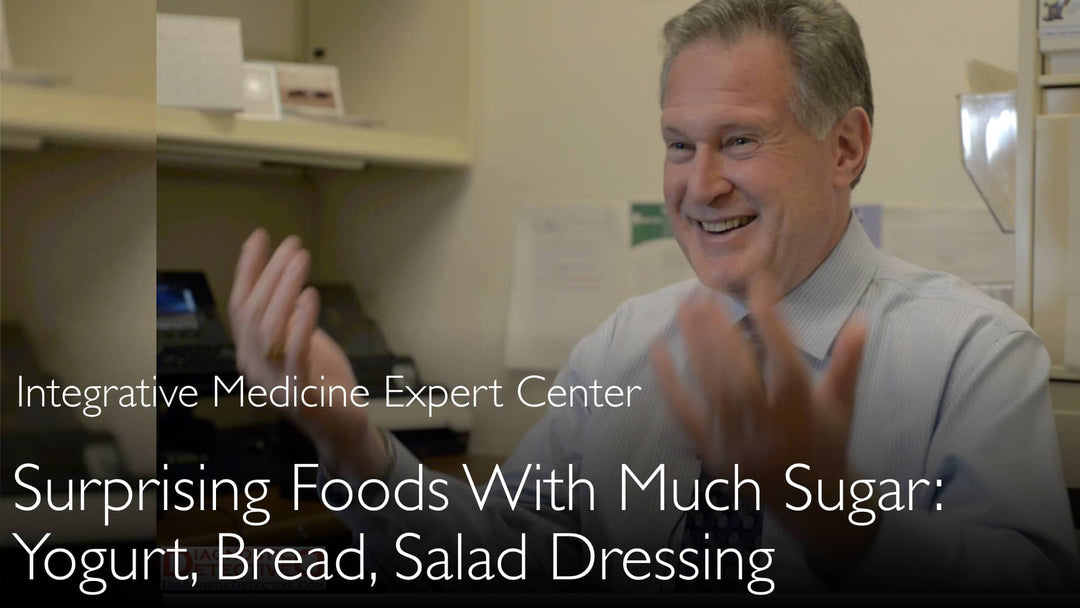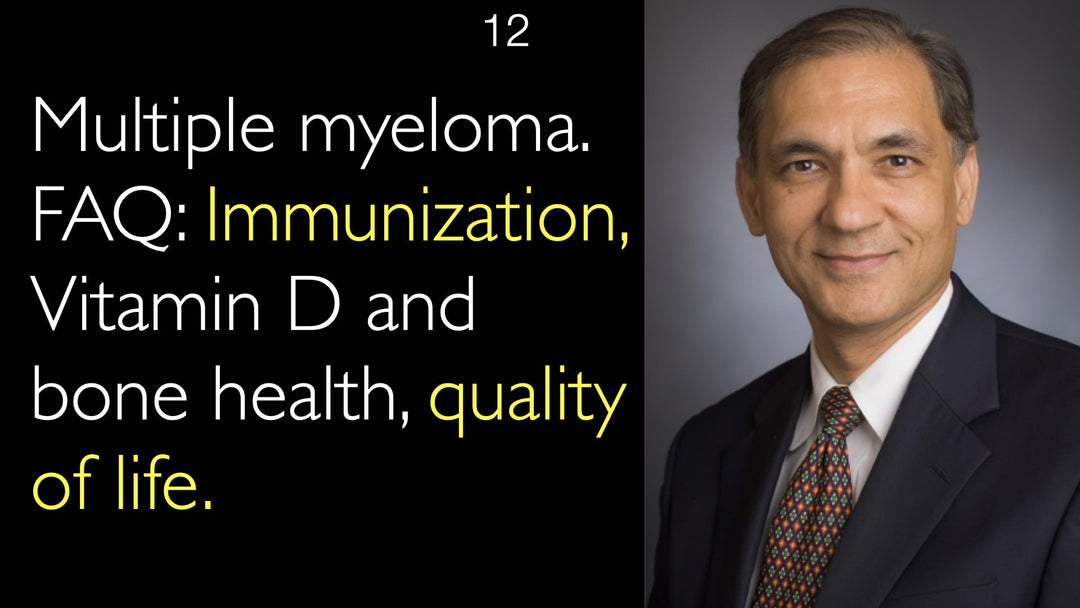Dr. Robert Lustig, MD, reveals hidden sugars in products marketed as healthy, helping patients make informed dietary choices to combat metabolic syndrome and obesity.
Hidden Sugars in Common Foods: A Guide to Unexpected Sources
Jump To Section
- Yogurt's High Sugar Content
- Sugar in Salad Dressing
- Bread and Sugar as a Preservative
- Other High Sugar Foods
- Food Industry Practices and Health
- Full Transcript
Yogurt's High Sugar Content
Dr. Robert Lustig, MD, identifies yogurt as a primary example of a food with a surprisingly high sugar content. He explains that traditional yogurt, like that consumed in Europe, is essentially sour milk. However, in the United States, most commercial yogurt is transformed into a dessert-like product. A plain yogurt contains about 7 grams of sugar, which is natural lactose from milk. Dr. Lustig points out that American fruit-flavored yogurts typically contain 19 to 23 grams of sugar due to added sweeteners like high-fructose corn syrup, sucrose, or evaporated cane juice.
This addition means a single serving of flavored yogurt can contain the sugar equivalent of a bowl of breakfast cereal. Dr. Anton Titov, MD, discusses this deceptive practice with Dr. Lustig, highlighting how a food perceived as healthy can significantly contribute to overnutrition and metabolic health issues.
Sugar in Salad Dressing
Salad dressing is another common source of hidden sugars that Dr. Robert Lustig, MD, warns consumers about. The shift toward low-fat products led the food industry to a problematic solution: reducing fat and dramatically increasing sugar to compensate for lost flavor. This practice means that a seemingly healthy salad can become a vehicle for a large dose of added sugar, undermining its nutritional value entirely.
Dr. Anton Titov, MD, and Dr. Lustig emphasize that this is a widespread issue, making it difficult for individuals to make truly healthy choices without carefully scrutinizing ingredient labels. This hidden sugar intake is a significant factor in the development of metabolic syndrome.
Bread and Sugar as a Preservative
The surprisingly high sugar content in commercial bread is directly tied to its extended shelf life, a key profit driver for the food industry. Dr. Robert Lustig, MD, explains the science behind this: sugar acts as a preservative by displacing water in a process known as reducing water activity. This prevents staleness and mold, allowing a loaf of bread to last for weeks on a shelf, unlike fresh bakery bread that stales in a couple of days.
While this is economically advantageous for manufacturers, it adds unnecessary sugar to a dietary staple. Dr. Anton Titov, MD, explores this concept with Dr. Lustig, noting how this practice prioritizes corporate wallets over public health, contributing to the overnutrition epidemic.
Other High Sugar Foods
Beyond yogurt, salad dressing, and bread, Dr. Robert Lustig, MD, identifies several other foods with surprisingly high sugar content. Common condiments like barbecue sauce, tomato ketchup, and hamburger buns are often loaded with added sugars. Breakfast items such as cereals and granola, frequently marketed as health foods, can also be significant sources.
Beverages like fruit juice and lemonade are particularly problematic due to their high sugar concentration and lack of fiber. Dr. Anton Titov, MD, and Dr. Lustig stress that added sugar is now present in approximately 80% of all packaged food products, making vigilance essential for managing conditions like obesity and metabolic syndrome.
Food Industry Practices and Health
The pervasive use of sugar is a calculated business strategy by the food industry, as detailed by Dr. Robert Lustig, MD. Sugar is a cheap ingredient that enhances flavor, acts as a preservative to reduce product depreciation, and increases palatability, driving consumer consumption and repeat purchases. This creates a direct conflict between corporate profitability and public health outcomes.
Dr. Lustig frames this dynamic as a war where financial interests often win at the expense of population health, fueling the crises of metabolic syndrome and overnutrition. Dr. Anton Titov, MD, concludes that obtaining a medical second opinion can help patients navigate these dietary challenges and confirm the best treatment path for their metabolic health.
Full Transcript
Surprisingly high sugar foods are bread and yogurt. Why do yogurt, salad dressing, and bread now contain a lot of sugar? The food industry knows it very well. Excess sugar in food products is lucrative.
Dr. Robert Lustig, MD: Sugar is a preservative. This is why the food industry loves to put a lot of sugar in food. Evolution taught us to like sugar. The food industry sells many surprising foods that are loaded with sugar. Salad dressing and yogurt are just two of them.
Cereals, granola, and ketchup have very high sugar content. Fruit juice and lemonade are also surprisingly high in sugar. Surprisingly high sugar foods are not only bread, yogurt, and salad dressing. Commercial big store bread also has high sugar content. Sugar is used to preserve bread for weeks.
There are many other high sugar foods on the shop shelf. It is not just bread and yogurt. Added sugar at this point exists in about 80% of all food products.
Dr. Anton Titov, MD: What are examples of high sugar content foods that are not obvious?
Dr. Robert Lustig, MD: The one food that really drives me insane is yogurt. In Europe, yogurt is sour milk. There is little difference between yogurt and the milk that sours in your refrigerator. For yogurt, you choose the bacteria that does the souring. In Russia, you have a very long history of yogurt consumption.
I even remember the time I was a child here growing up in the United States. Then Dannon yogurt had a commercial of these hundred and twenty-year-old Georgians doing cartwheel acrobatic flips, because they were still so healthy. Yogurt is sour milk, except in America, where yogurt is dessert.
If you look at the side of a package, it says that there are seven grams of sugar. All sugar is lactose or milk sugar, which is perfectly fine. Nothing wrong with it. You take that plain yogurt. Then you add whole fruit to it to cut the sourness.
But here in America, you buy yogurt in the store. It has 19 to 23 grams of sugar. You look at the side label. It is high with fructose corn syrup or sucrose, or it has evaporated cane juice. Cane juice is supposed to be healthier—nothing of the sort.
The point is when you buy a fruit-flavored yogurt in America, you are buying a plain yogurt plus a bowl of breakfast cereal. That's the problem. Yogurt is one example of a food that is supposed to be healthy but it isn't.
Salad dressing is another example. When we went low-fat salad dressing, it tasted awful. So what the food industry did was this: they added sugar. Cut half of the fat, add double sugar. Salad dressing is a problem. You think you are eating a healthy salad, but you are not eating healthy at all.
Barbecue sauce, tomato sauce, hamburger buns, bread. You buy a loaf of bread at the local bakery. How soon before it stales? Maybe two days? No sugar. But you buy a loaf of bread at a commercial grocery. It lasts for weeks! Three weeks! How come?
Why does commercial store bread last for 3 weeks? The sugar in the baking process displaces water. It is called water activity. The industry knows that. Basically, sugar is a preservative. It allows you to have the bread on a shelf longer. Sugar decreases depreciation.
This is very good from a profit standpoint for the food industry. Not so good for our health. Ultimately, this is the war. It is basically your wallet or your health. Today, the wallets are winning, and we are losing.
Surprisingly high sugar foods: bread and yogurt. Salad dressing, barbecue sauces, and hamburger buns are also high in sugar.







